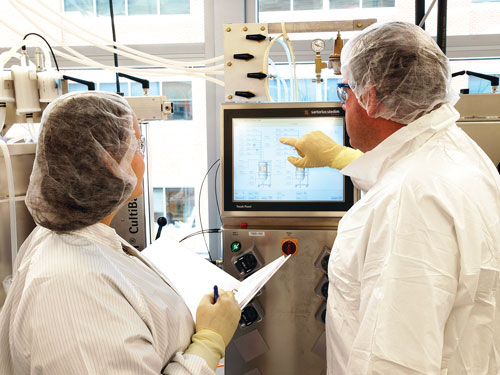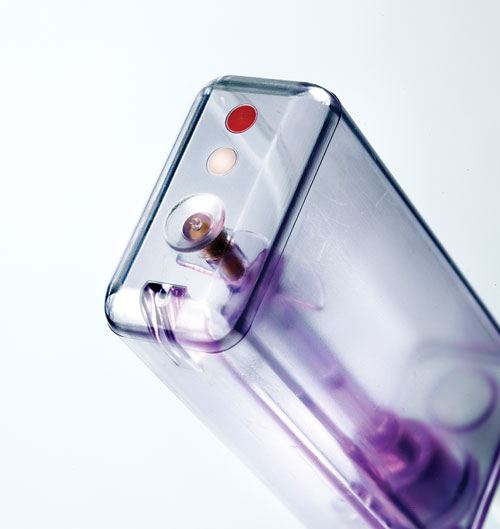April 1, 2011 (Vol. 31, No. 7)
Angelo DePalma Ph.D. Writer GEN
New Optimization Strategies Help to Make a Good Thing Even Better
To borrow an expression from the world of competitive chess, “every Russian schoolboy knows” what factors affect biomanufacturing product yield and quality. Start with a robust cell line, select for viability and expression level, then experiment around media, feed, and bioreactor/fermentor conditions. Throw in some analytics and you’re set.
Yet assembling these building blocks is a balancing act, requiring science, timing, logistics, the manufacturer’s and/or sponsor’s experience, efficiency of technology transfer from premanufacturing (whether in-house or not), and needs for material quantity and quality.
The ultimate goal of cell-culture optimization is to create a robust, reproducible, predictable process. “Optimization has traditionally focused on cell growth and productivity, and higher throughput” says Bretta Erskine, who heads cell culture supplements marketing for EMD Millipore. Strategies for improving cultures include cell-line optimization, media and feed development, and optimization of bioreactor conditions. Where automation has improved how cells are selected and assayed, single-use containers for both cell culture and media/buffer-related activities improve throughput and flexibility, particularly during the early production.
Productivity is still a top priority, but a change in mind-set leading to greater appreciation of quality-by-design (QbD) has caused a shift in how manufacturers approach cell culture. “Once you’re past cell-line development you still want to produce a lot of cell mass and product, but here the tweaking and optimization is more focused on quality,” Erskine explains.
The tradeoff between quality and productivity remains quite real, to the point where one must sometimes sacrifice cell mass and titer. “But that’s a good thing. In the past the problem was that people were not focusing enough on quality. If you produce a ton of protein and you have to throw half of it away, what good is it? It’s a trade-off, but one that’s worth it in the end.”
Millipore, for example, uses a flow cytometer from its Guava Technologies division to monitor cultures for evidence that significant numbers of cells are dying. Cell death is accompanied by release of proteases, which degrade proteins, impurities that may complicate downstream processing. Apoptosis is particularly troublesome in fed-batch cultures.
Kevin Gilbride, Ph.D., of Gilbride Consulting agrees that cell viability is a huge factor in product quality. “You have to monitor cells constantly, not just during manufacturing, but in process development.”
At one of his earlier industrial positions, Dr. Gilbride replaced a trypan blue stain with a much more complex, but indicative assay for externalized phosphatidylserine. “Trypan blue can underestimate apoptosis. It’s a large molecule that dying cells can’t always incorporate. Whereas healthy cells never externalize phosphatidylserine.”
A Contractor’s View
Service companies like contract manufacturing/research firm Paragon Bioservices, Cytovance, and Sheffield Bio-Science have distinct but similar perspectives on how best to optimize cell cultures. Ever practical, contractors seek constant improvement while facing stringent deadlines and tight output requirements.
Paragon, which specializes in microbial, mammalian, and insect cell culture, receives projects at any stage from discovery through early clinical testing. “Quality and quantity are always concerns, but development projects usually focus on quantity—getting enough material for the client to reach the next development phase,” says Paul Price, Ph.D., an immunologist at the company. Quality, assisted by analytics, moves to the forefront as the project develops, and later on quantity and quality become “inseparable.”
Dr. Price puts cell lines and culture media and feeds at the top of the list for optimizing both cell growth and product quality for mammalian and microbial cultures. On the microbial side, one of the most straightforward ways to improve expression is by increasing cell density while optimizing the expression and promoter systems.
Technology transfer from sponsor to contractor, particularly at early stages, may be quite variable, mostly because process/culture data are not yet available. Tech-transfer gains in significance later on, yet even then contractors do not always get everything they want or need. “Process knowledge is not as available, all the time, as we would like,” Dr. Price says.
Cytovance, similarly, receives projects from as early as gene sequences to late-stage clinical development. Time is of the essence, says Jeffrey Su, Ph.D., chief scientist, who relies on commercial basal media and feeds to achieve “adequately productive” processes for preclinical and early-stage clinical testing. One of the company’s preferred platforms is CD OptiCHO™ Medium from Invitrogen (part of Life Technologies), and supplements designed to work with that product. Optimization is often limited to feed scheduling, followed by tweaking bioreactor and environmental conditions, which Dr. Su refers to as a type of process “polishing.”
“At this stage our customers want it fast and cheap,” he says. “Yet CMOs have to balance their sponsors’ time lines and productivity.”
PAT has a role in cell-culture optimization at CMOs, but not as an ongoing means of characterizing the process. “We’re looking for fairly obvious changes in early-stage process development,” says Dr. Su. “Given the expense and complexity of systems that perform real-time online monitoring and feedback control, PAT would probably not be of much help [at that stage].”
It could be useful later on, he notes, for ongoing fine-tuning of a process with a successful manufacturing history behind it. “But PAT generates a lot of information, and with it the burden of having to make use of that information. It’s a double-edged sword.”
Sheffield Bio-Science, a manufacturer of supplements for upstream cell-culture optimization and provider of related services, understandably feels that media and feed optimization is where the lion’s share of improvement in cell culture occurs (a sentiment shared by most cell-culture experts).
“We have our own in-house bioreactors, and we do study fed-batch conditions as well, but it’s always within the context of how that interfaces with supplementation,” says R&D director Chris Wilcox, Ph.D.
Yet Dr. Gilbride notes that for most contract manufacturers and some cell-culture development service firms as well, sponsors provide little leeway in how cells are maintained, grown, and fed. “They often specify their own media, supplements, and feeding schedules.”
The focus changes somewhat with customer projects where specific conditions are specified to vary, but even there the focus remains primarily on reactor conditions as they relate to supplementation.
A major challenge is transferring processes to animal-derived component-free (ADCF) media and supplements. Where most U.S. and European developers have been taught to “think” in terms of ADCF products, many companies in the Asia-Pacific region still cling to bovine or porcine-based media.
Sheffield’s job in optimizing its processes involves either significantly reducing the ADCF burden, or completely replacing those ingredients with less risky hydrolysates or chemically defined ingredients. The latter, Robert Shaw, director of commercial development for EMD Millipore, admits, “take more time and involve design of experiment around what impacts on yield defined metabolic enhancers may have.”
Sheffield scientists usually begin with a “lean and mean” medium so the full impact of each supplement can be determined without interference.
Sheffield is undoubtedly biased toward media-feed strategies, but this is merely a reflection of the business of cell-culture optimization, and the needs of firms that seek the assistance of service companies. “What holds true in the U.S. and EU may not hold in India, China, and Brazil.” Many of Sheffield’s overseas clients lack the resources to devote effort to upstream cell-line development or molecular biology. “A lot of the bang for the buck they get is from media development,” Shaw says.

According to Paragon Bioservices, one of the most straightforward ways to improve expression is by increasing cell density while optimizing the expression and promoter systems.
Over Baseline
A problem faced during cell process development is discerning the real effects of varying conditions from the noise. The use of extremely simple media during feed and supplement optimization, mentioned earlier, is an example of how to assure that real effects stand out.
Human variability is another area that may drown out signs of significant improvement (or problems).
“Cell culture involves a lot of manual processing,” observes Tim Ward, director of strategic marketing at The Automation Partnership (TAP). “Automation eliminates dependence on workers, while completing repetitive processes with a lot less labor and improved efficiency.”
Despite practice, consistency is difficult to achieve with manual manipulations. Small differences in how a task is performed from day to day, between or among individuals, even when they are following the same protocol, can result in cells experiencing different conditions.
The efficiency and consistency of automation, Ward says, “opens up a whole spectrum of ways to employ automated systems to change the way cell culture is done, for everything from producing cells for experimentation through process development and manufacturing.”
Readers are well aware of the value of automation in carrying out repetitive tasks on large numbers of small samples, e.g., in microtiter plates. The same level of automation, consistency, and control are available for cell-culture optimization as well. For example, TAP’s ambr™ cell culture workstation carries out up to 48 bioreactor experiments simultaneously in microreactors that mimic bioreactors in most important physical/mechanical respects.
With 10–15 mL of working volume, ambr microreactors are much larger than microwells. The TAP reactors also employ impeller stirring, constantly monitor pH and dissolved oxygen, and feature independent control of oxygen and carbon dioxide.
“Customers want to do many more early experiments, and the ambr system allows that,” says Shaw, who opines that ambr compliments but does not replace microplates. “You still need two stages. The first should still be a front-end screen, some form of selection pressure or colony picking, which is best done in 96-deep-well plates.”

The Automation Partnership says that ambr™ mimics the characteristics of classical bioreactors at microscale (10–15 mL) by using cost-effective, disposable microbioreactors controlled by an automated workstation. DO and pH spots on the base of the ambr bioreactor are shown.
Stem Cells Are Different
Optimizing stem cell cultures is hampered by the relative newness of stem cell technology and the diversity of nonpluripotent progenitor cells. Nothing close to CHO or any other standard production-worthy mammalian or microbial cell exists in the stem cell world. Scales are much smaller, and the goal is not a cell-derived product but the cells themselves.
Most CHO cells developed for new processes are expanded to production scale in serum-free or chemically defined media, whereas stem cell cultures still rely heavily on serum-based ingredients. And while some attachment-dependent cells are still employed in legacy processes, particularly for vaccines, nearly all stem cells exist in that format. “We’re still very early in the game,” says Robert Shaw, director of commercial development for EMD Millipore.
Stem cell specialists recognize the need to move toward better defined media, and to modernize stem cell culture to permit industrial-scale production. “Individual companies have their own strategies for achieving that,” Shaw observes, but a thorough understanding of what makes stem cells tick stands in the way. Where CHO cells tolerate a relatively wide range of conditions, including media, feed, and supplementation, slight alterations in conditions can profoundly affect a stem cell’s fate, or its utility toward its intended purpose.
Shaw believes it will be possible, eventually, to create stem cell processes that are as robust and industrialized as CHO processes. “But if it is not possible, it will be a major limitation for stem cell therapy.”







